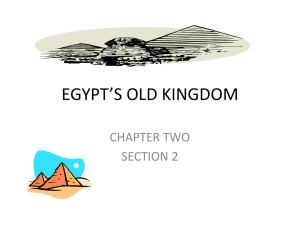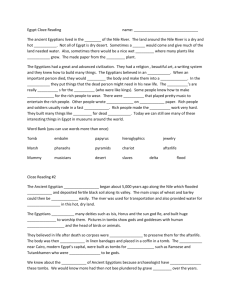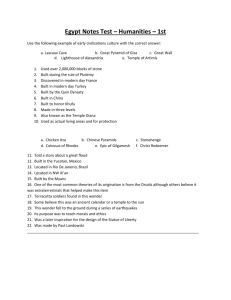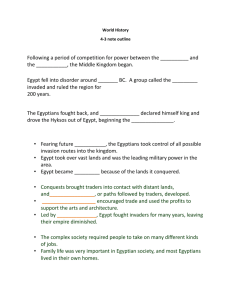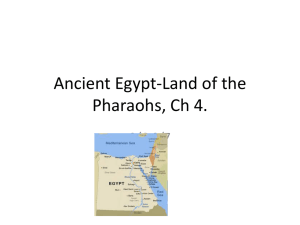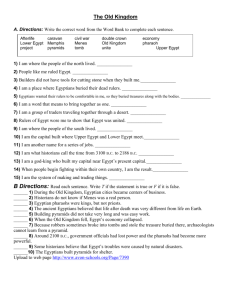NAME: : :______ PRE-AP CHAPTER 4 TEST: ANCIENT EGYPT
advertisement
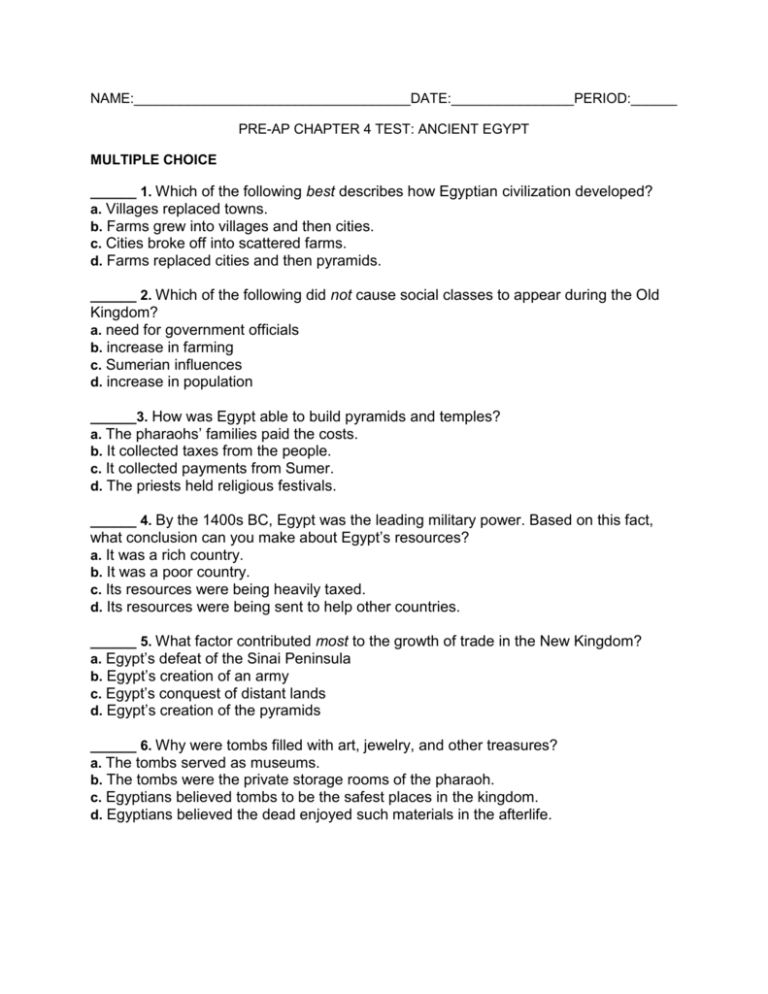
NAME:____________________________________DATE:________________PERIOD:______ PRE-AP CHAPTER 4 TEST: ANCIENT EGYPT MULTIPLE CHOICE ______ 1. Which of the following best describes how Egyptian civilization developed? a. Villages replaced towns. b. Farms grew into villages and then cities. c. Cities broke off into scattered farms. d. Farms replaced cities and then pyramids. ______ 2. Which of the following did not cause social classes to appear during the Old Kingdom? a. need for government officials b. increase in farming c. Sumerian influences d. increase in population ______3. How was Egypt able to build pyramids and temples? a. The pharaohs’ families paid the costs. b. It collected taxes from the people. c. It collected payments from Sumer. d. The priests held religious festivals. ______ 4. By the 1400s BC, Egypt was the leading military power. Based on this fact, what conclusion can you make about Egypt’s resources? a. It was a rich country. b. It was a poor country. c. Its resources were being heavily taxed. d. Its resources were being sent to help other countries. ______ 5. What factor contributed most to the growth of trade in the New Kingdom? a. Egypt’s defeat of the Sinai Peninsula b. Egypt’s creation of an army c. Egypt’s conquest of distant lands d. Egypt’s creation of the pyramids ______ 6. Why were tombs filled with art, jewelry, and other treasures? a. The tombs served as museums. b. The tombs were the private storage rooms of the pharaoh. c. Egyptians believed tombs to be the safest places in the kingdom. d. Egyptians believed the dead enjoyed such materials in the afterlife. PRACTICING SOCIAL STUDIES SKILLS Study the map below and answer the question that follows. ______ 7. Which area was probably the largest source of gold for the Egyptians? a. Mycenae b. the Nubian desert c. the Western desert d. the Euphrates River 8. What was the northernmost city of the New Kingdom? ______________________________________________________________________ 9. What goods would have been traded between Byblos and Punt? ______________________________________________________________________ COMPLETION 10. The southern part of ancient Egypt was called________________________ . (Lower Egypt/Upper Egypt) 11. The Egyptians began to build pyramids during the_____________________ . (Old Kingdom/Middle Kingdom) 12._______________________ united the Middle Kingdom around 2050 BC. (Ahmose of Thebes/Mentuhotep II) 13. The_____________________ helped historians understand hieroglyphics. (Rosetta Stone/Temple of Karnak) TRUE/FALSE ______ 14. The Mediterranean Sea made it easy for other countries to invade Egypt. ______ 15. The Egyptians built pyramids for all people who died. ______ 16. The rule of Mentuhotep II began the Middle Kingdom. ______ 17. The Egyptians believed that temples were the homes of the gods. MATCHING Match each item with the correct statement. _______18. Egypt’s first pharaoh who united Upper and Lower Egypt ______ 19. Imaginary creature with the body of a lion and the head of another animal ______ 20. Pharaoh best known for building the Great Pyramid ______ 21. Specially treated bodies wrapped in cloth ______ 22. The application of scientific knowledge for practical purposes ______ 23. Pharaoh who defended Egypt against the Hittites ______ 24. A long-lasting, paper-like material made from reeds ______ 25. A tall, four-sided pillar that is pointed on top ______ 26. Paths followed by merchants and traders ______ 27. Period of time during which Egypt reached the height of its power a. Khufu b. Ramses II c. sphinx d. New Kingdom e. obelisk f. engineering g. trade routes h. hieroglyphics i. Menes j. papyrus k. Queen Hatshepsut l. King Tutankhamen m. mummies SHORT ANSWER 28. Why did pharaohs have absolute power? _____________________________________________________________________________________ _____________________________________________________________________________________ 29. What were some things that Queen Hatshepsut accomplished? _____________________________________________________________________________________ _____________________________________________________________________________________ _____________________________________________________________________________________ _____________________________________________________________________________________ 30. How do historians know that the afterlife was important to the Egyptians? ______________________________________________________________________ ______________________________________________________________________ ______________________________________________________________________ ______________________________________________________________________ ______________________________________________________________________
